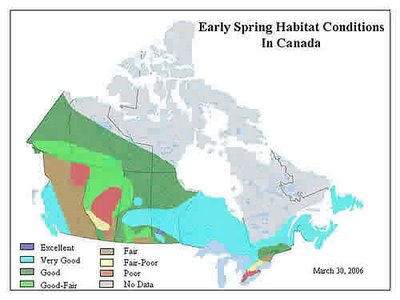
Early Spring Habitat Conditions in CanadaMarch 30, 2006
In the coastal region of British Columbia the snowpack is still good, precipitation is about normal and spring conditions are expected to be very good. The snow geese are now back in the Fraser Delta, and applying pressure to forage fields. This grazing pressure means that upland foraging habitat values have probably declined a bit, but foreshore conditions (due to eelgrass growth, for example) have improved for other species, so the net overall effect on habitat conditions is about zero. Initial crop damage assessments indicate that compensation for reseeding, etc. will be higher this year. The goose population is estimated at 80,000, which is within the normal range, but the ratio of juveniles:adults is significantly higher. Brant survey numbers in the coastal region were lower than expected. In the central Interior spring weather has arrived, and many more waterfowl are now moving through the area as the spring thaw progresses; new arrivals included tundra swans, snow geese, canvasbacks, redheads, and a single long-billed curlew. Without additional precipitation in the coming months, spring conditions are expected to be below average in the central Interior. In the southern and southeast Interior there has been little recent snowfall, but total snow accumulation is still about average (although mostly melted at lower elevations). Spring conditions in the southern and southeastern Interior are expected to be close to average and fair, respectively. The Peace and northeast regions received slightly more snow in the beginning of March but habitat conditions haven't improved. Runoff potential in the Peace region is still only fair at best. Spring breakup has now begun, and the first waterfowl (Canada Geese, of course) have shown up in the Dawson Creek area, both of which events are earlier than usual.











No comments:
Post a Comment